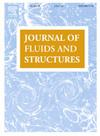用不同CFD方法对悬臂杆在水湍流轴流中的耦合流固耦合模拟
IF 3.5
2区 工程技术
Q1 ENGINEERING, MECHANICAL
引用次数: 0
摘要
本文对Cioncolini等人的悬臂杆在水轴流中的实验运动进行了流固耦合数值模拟。实验配置的目的是代表一个核燃料棒,在水力直径方面。实验测量了水的速度分布和结构振动。分别对Re=1.5⋅104和Re=1.9⋅104进行了数值模拟。使用code_Saturne测试了不同的CFD方法:壁面解析双方程线性黏度模型(k-ω-SST)、两种壁面解析雷诺应力模型(SSG和LRR)、壁面解析雷诺应力模型(EBRSM)和壁面解析混合URANS/LES模型(DDES)。采用一维有限元欧拉-伯努利梁模型对结构进行了数值模拟。采用任意拉格朗日欧拉方法,实现了两个求解器之间的双向耦合。出乎意料的是,墙型雷诺应力模型比高分辨率的EBRSM和DDES计算出更高的振动幅值。频域分析可以识别出LRR和SSG计算的相对低频的高能量流速度和流激力谐波,而EBRSM和DDES结果中没有,这从振动响应的角度解释了数值结果。LRR和SSG的这种特殊行为似乎与壁函数边界条件有关。LRR和SSG计算的均方根振动幅值接近实验值,而EBRSM和DDES低估了实验值的2.5倍。模拟了一个假设的杆的小永久变形(液压直径的4%),并发现计算出的振动幅值增加了2倍。还测试了单向耦合,以评估阻尼和附加质量对结果的影响。本文章由计算机程序翻译,如有差异,请以英文原文为准。
Coupled fluid–structure simulations of a cantilever rod in water turbulent axial flow with different CFD approaches
Fluid–structure numerical simulations of an experimental campaign by Cioncolini et al. of a cantilever rod in water axial flow were performed. The experimental configuration aims at representing a nuclear fuel rod, in terms of hydraulic diameter. Water velocity profiles and structure vibrations were measured experimentally. Two of the experimental tests were simulated numerically, one at Re=1.5104 and one at Re=1.9104. Different CFD approaches were tested, using code_Saturne: a wall-resolved two-equation linear viscosity model (k--SST), two wall-modeled Reynolds stress models (SSG and LRR), a wall-resolved Reynolds stress model (EBRSM) and a wall-resolved hybrid URANS/LES model (DDES). The structure was simulated through a one-dimensional finite element Euler–Bernoulli beam model. A 2-way coupling was implemented between the two solvers, with an Arbitrary Lagrangian Eulerian approach. Unexpectedly, wall-modeled Reynolds-stress models were found to calculate higher amplitudes of vibration than the higher-resolution EBRSM and DDES. The frequency domain analysis allowed to identify high energy flow velocity and flow-induced force harmonics at relatively low frequency calculated by LRR and SSG, not present in the EBRSM and DDES results, which explain the numerical results in terms of vibration response. This specific behavior of LRR and SSG seems to be linked to the wall function boundary condition. LRR and SSG calculate a rms amplitude of vibration close to the experiments, whereas EBRSM and DDES underestimate them by a factor of 2.5. A hypothetical small permanent deformation (4% of the hydraulic diameter) of the rod was simulated and found to increase the calculated vibration amplitudes by a factor of 2. 1-way coupling was also tested to assess the influence of damping and added mass on the results.
求助全文
通过发布文献求助,成功后即可免费获取论文全文。
去求助
来源期刊

Journal of Fluids and Structures
工程技术-工程:机械
CiteScore
6.90
自引率
8.30%
发文量
173
审稿时长
65 days
期刊介绍:
The Journal of Fluids and Structures serves as a focal point and a forum for the exchange of ideas, for the many kinds of specialists and practitioners concerned with fluid–structure interactions and the dynamics of systems related thereto, in any field. One of its aims is to foster the cross–fertilization of ideas, methods and techniques in the various disciplines involved.
The journal publishes papers that present original and significant contributions on all aspects of the mechanical interactions between fluids and solids, regardless of scale.
 求助内容:
求助内容: 应助结果提醒方式:
应助结果提醒方式:


